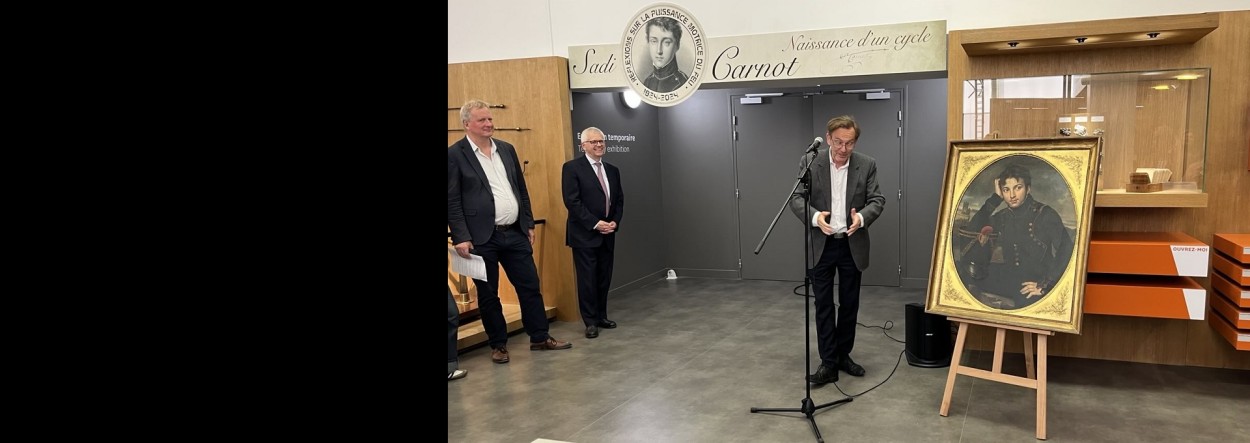Mus'X enriches its collections with the portrait of an alumnus, dated 1814
 De gauche à droite : Kees van der Beek ; Philippe Moiroud, président de la SABIX et Jean-Paul Cottet, délégué général de la FX
De gauche à droite : Kees van der Beek ; Philippe Moiroud, président de la SABIX et Jean-Paul Cottet, délégué général de la FX
Mus'X, École Polytechnique’s museum, is adding to its collections a portrait of a former student of the École impériale polytechnique in front of Fort de Vincennes, dated 1814, by Césarine Davin-Mirvault (1773-1844), a painter and miniaturist who was a pupil of Jacques-Louis David.
The Mus'X showcases École Polytechnique’s heritage collections, managed by its library and the legacy of 225 years of history and scientific discoveries. Opened in 2018, it houses a permanent exhibition of 300 items and organizes temporary exhibitions.
In March 2021, it revealed its unpublished collections on Google Arts & Culture making a collection of almost 2,000 items from its scientific, historical and artistic collections accessible to the general public for the first time. As an extension of this achievement, Mus'X welcomed stakeholders in the Museums Metavers project to an event on December 3, 2024. An operation supported by the French government as part of the “Digitization of heritage and architecture” initiative of the cultural and creative industries sector of the France 2030 program, Museums Metavers aims to meet the need for aggregation of heritage digitization by offering visitors a single point of entry into a 3D universe with multiple portals to virtual exhibition venues.
The young polytechnician portrayed by Césarine Davin-Mirvault is shown seated, holding his head with his right hand, elbow resting on his shako, in his Ecole polytechnique uniform with its imperial eagle buttons. In the background are artillerymen with cannons, ready to defend Paris from the Austro-Russian-Prussian Allies, just before Napoleon's capitulation on March 31, 1814, marking the fall of the First Empire.
For Césarine, this painting marks the end of an era, as she often portrayed the dignitaries of the Empire. It also ties in with the rich iconography of polytechnician involvement in most of the major French political crises of the 19th century.
A still enigmatic identity
Who's the student pictured here? For the moment, we don't know. In fact, he was identified in the sale catalog as a certain M. Petit, a student attached to the Vincennes battery.
The archives' matriculation registers list three students bearing the Petit surname for the classes that took part in the Battle of Paris; they are all in the class of 1812.
Two of them, Narcisse and Jean-Jacques, have blond hair and blue eyes. The third, Joseph Petit, had gray eyes and light brown hair. Here, however, the student has brown eyes. So it's not Petit.
Suspected to be Bonapartist bastion, École Polytechnique was demilitarized by Louis XVIII, and its students, most of whom were liberal-minded, remained rebellious and hostile to the powers that be, taking part in the revolution of 1830 and even more so in that of 1848... then opposing the coup d'état of the prince-president, the future Napoleon III.
Portrait gallery
The polytechniciens' participation in the July Revolution of 1830 and the so-called Three Glorious Days (July 28, 29 and 30), which put an end to the second Restoration and brought a new king, Louis-Philippe Iᵉʳ, to the throne, at the head of a new regime, the July Monarchy, was notably illustrated by Georges Moreau de Tours' painting, “The death of the polytechnician Vaneau” (X1829), painted in 1891, acquired by the State and on deposit at École Polytechnique since 1976.
In his famous painting, “La Liberté guidant le peuple” (Liberty guiding the people), painted in late 1830, Delacroix also evokes the involvement of polytechnicians in the Three Glorious Days. A polytechnician in uniform appears in the group of workers and bourgeois, old and young, led by Liberty in a Phrygian cap waving a tricolor flag.
Césarine Davin-Mirvault's painting is also part of the gallery of painted portraits of Polytechnicians in the uniform of their School , such as that of Claude-Armand Gérôme (1827-1850) by his brother Jean-Léon (1824- 1904) sold at the Drouot auction house in June 2013 and acquired by subscription in 2017 by the Fitzwilliam Museum (University of Cambridge) on the occasion of its bicentenary, or that of Baron Alexandre Legros in polytechnician uniform by Pierre Duval Le Camus (1790 - 1854), slightly younger than Césarine, who was less linked to Bonapartist commissions and made a career for himself under the Restoration, becoming the preferred painter of the Duchesse de Berry. The portrait of Sadi Carnot (X1812) by Louis-Léopold Boilly (1761-1845), a little older than Césarine, evokes the exhibition devoted to the father of thermodynamics by the Mus'X from May 15 to December 20, 2024, to mark the bicentenary of the publication of Carnot’s “Reflections on the motive power of fire and the machines for developing this power”.
The painting was officially handed over to the School on May 13, 2025, by Kees van der Beek, the library being attached to the Research Department, and by SABIX and the Foundation, patrons of this operation.
 Support l'X
Support l'X